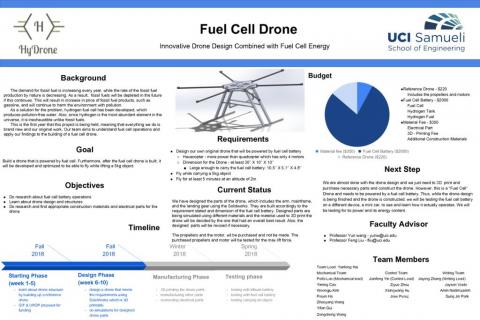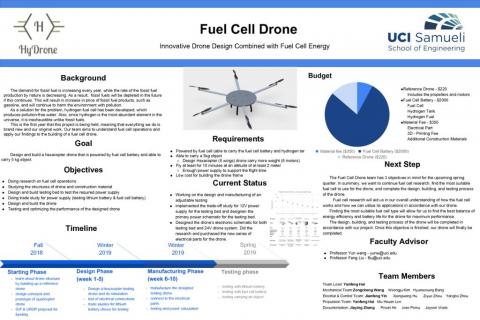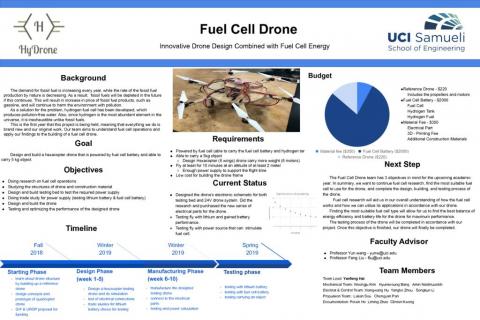Fuel Cell Drone
Background
In the United States, more than 80% of its total energy comes from fossil fuels. Fossil fuel products, such as plastic, are essential to our lives, and the demand for this energy increases each year. However, as the rate of fossil fuel consumption rises, the rate of fossil fuel production will fall behind, which will result in fossil fuels depleting. With fossil fuel production decreasing and demand increasing, products such as gasoline will be more expensive and will continue to harm the environment.
As a result, the world has been looking for clean and renewable fuel. The solution developed for this problem is the hydrogen fuel cell. Hydrogen fuel burns with oxygen and produces pollution-free water. Also, hydrogen is the most abundant element in the universe, which means that it is inexhaustible, unlike fossil fuels.
Although hydrogen fuel meets all the demands the world is requiring, it has been difficult to commercialize it because it is still considered to not be cost-efficient. Although hydrogen fuel might not be suitable for large vehicles such as cars and airplanes, it can still be used to power small devices such as mini cars and drones.
This is the first year that this project is being held, meaning that everything we do is brand new and our original work. Our team aims to understand fuel cell operations and apply our findings to the building of a fuel cell drone.
Advantages of a fuel cell drone
- Hydrogen fuel cells are a pollution-free form of power
- a hydrogen tank attached to a drone will generate more energy than a LiPo battery of the same weight
- Hydrogen fuel cells enable longer flight times
-
Hydrogen fuel cells can be refueled quickly
- Orca1, a mobile hydrogen fueling station can refuel a hydrogen cell within a few minutes
-
Hydrogen-fueled drones can function in low temperatures
- Opens up more uses for drones in Northern and Southern latitudes
Goal and Objectives
Build a drone that is powered by a fuel cell. Furthermore, after the fuel cell drone is built, it will be developed and optimized to be able to fly while lifting a 5kg object.
-
Objectives
- Goal
- Design and build a hexacopter drone that is powered by fuel cell battery and able to carry 5 kg object
- Doing research on fuel cell operations
- Studying the structures of drone and construction material
- Design and build a testing bed to test the required power supply
- Doing trade study for power supply (testing lithium battery & fuel cell battery)
- Design and build the drone
- Testing and optimizing the performance of the designed drone
Ongoing Progress
-
Design and build an adjustable testing bed
- Test the max lift force of the current motor/propeller
- Figure out the operation of the hybrid power supply system
- Implemented the trade-off study for 12V power supply for the testing bed and designed the primary power schematic for the testing bed.
- Determined important specifications of a different fuel cell and researched the different characteristics and figure out the simplest converter that suit for the fuel cell battery.
- Designed the drone’s electronic schematic for both testing bed and 24V drone system. Did the research and purchased the new series of electrical parts for the drone.
- Soldered and assembly the new circuits and ensure wires with different plugs for the easy connection. Calibrate the new DJI flight controller with new 24V power system with a power monitor.
Contacts
Faculty Advisor(s): Prof. Yun Wang yunw@uci.edu
Student Contact(s): Hai Yanfeng yanfengh@uci.edu
Members
Yanfeng Hai Jianfeng Yin Zongcheng Wang Jiaying Zhang
Yangbo Zhou Ziyue Zhou Woongju Kim Peixin He
Mu Hsuan Lee Xiangwang Hu Hyunseoung Bang Jose Perez
Liming Zhao Jason Viado



